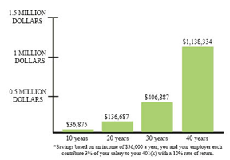 |
||||
      |
||||
|
Two young boys grudgingly relinquish their comfy leather seats as a young man approaches, dressed business casual in Dockers and a button down shirt. He gazes at the selection facing him, overwhelmed by its sheer massive size and in awe of its perfection. He has entered the drool zone, the wistful “If I won the lottery…” corner. A young employee approaches with the traditional, “May I help you with anything?” and barely pauses, anticipating the typically regretful “No thanks, just looking” response. He stops in his tracks and his mouth opens slightly as the man says, “Actually, I want that one” and points to a $2,000 flat screen, LCD television. This man is one of Wisconsin’s new young professionals who just entered the job market and is making more money than he knows what to do with. Why not buy a $2,000 television? Let’s talk cold, hard cash. Suppose that instead of buying the massive television, this man invests that $2,000 in a retirement account. Thirty years from now, he could have $112,170 in his pocket. If he decides to buy the television today and instead invests that $2,000 ten years from now, he will make only $59,556 in 2034 off the same investment. That television just cost him $52,614. The actual costs of these decisions add up quickly. With the uncertainty of Social Security, financial advisers agree that young professionals cannot expect sufficient income in retirement if they do not begin investing now. Unfortunately, the enticement of material goods and the long stretch of time before retirement blind young professionals to the realities of investing. “Invest early, invest often,” advises Ken Karr, an investment adviser for McSherry Associates. If ignored, this free advice could cost tens of thousands in later years. While most young professionals prefer prime rib to generic canned cat food, they are still not taking the necessary steps toward a solid retirement fund. The most typical excuse is a combination of reasons. A high debt load or low-income top the list of common defenses. “When you start out, you have to a.) start out at the bottom of the corporate ladder or b.) pay off student loans,” Karr says. Yet with careful financial planning, making loan payments and still saving a small percentage of a paycheck can be easy. Karr suggests setting up an account to take out a certain percentage from each paycheck. “Once you have that 6 to 10 percent taken out initially, it’s painless after that,” he explains. Keeping this “out of sight, out of mind” attitude can build an admirable fund, especially after wise investing. A lack of knowledge combined with the excuses of “it’s too early to plan” are the other intimidating factors keeping 20- to 30-year-olds from planning their retirements wisely. According to the Employee Benefit Research Institute (EBRI), workers ages 20 to 39 are less prepared for retirement than the average employee, but equally as confident that they will remain financially stable. This group also believes they will retire earlier than the typical age of 65, leading to the conclusion that lack of planning and an optimistic attitude will guarantee a secure and early retirement. Unfortunately, this is the real world. The retirement age is gradually increasing, and Social Security is expected to run out in the next few decades. A survey by the University of Wisconsin Survey Center revealed that 85 percent of 20-to 39-year-old Wisconsin residents admit they can’t rely on Social Security. But in blatantly ignoring such obvious truths, this generation of professionals may spend their retirement years serving food at the local restaurant instead of just dining there. Investing too late will not only make cat food suddenly seem appealing as an entrée, but also be more costly in the end. Increasing tax rates and rising costs of living make saving in later years more difficult. LaVon Schroeder of Oshkosh knows the drawbacks of postponing planning. “It’s costing me more now in my early 50s than it would have in my early 20s or 30s,” she says. “The financial impact is painful for those who don’t have things in line.”
|
||||||
|
|||||||
|
|||||||

